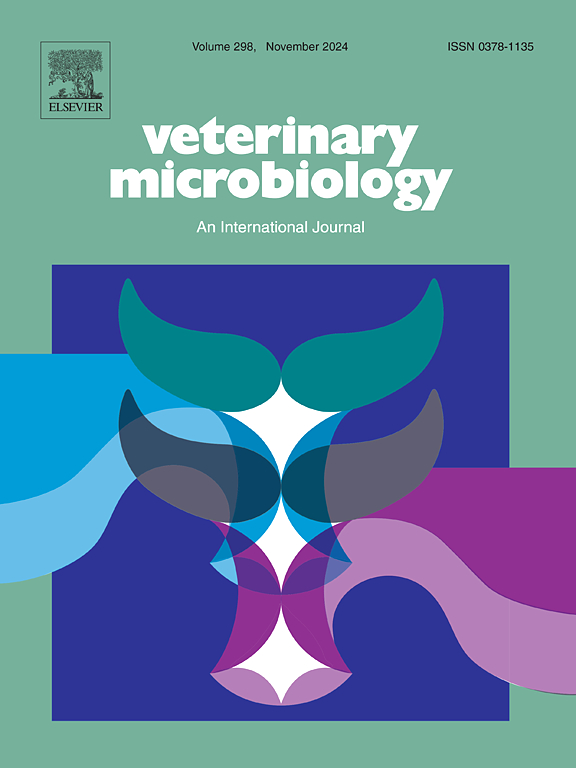Essential role of the interaction between classical swine fever virus core protein and cellular MYO1B in viral components transport to exosomes and titer maintenance
IF 2.4
2区 农林科学
Q3 MICROBIOLOGY
引用次数: 0
Abstract
Classical swine fever (CSF) is a severe disease caused by the highly contagious CSFV. Our previous study demonstrated that exosomes from CSFV-infected cells contained significant amounts of viral genome and Core (C) protein and were infectious. To further elucidate the mechanisms underlying the formation of these infectious exosomes, we investigated the intracellular transport of the C protein in this study. We first identified the synchronized transport of the C protein and viral genome to exosomes, distinguishing it from other structural proteins. This suggests that the C protein likely binds to the viral genome and is transported to exosomes as a nucleocapsid. Subsequently, Co-IP and co-localization experiments confirmed the interaction between the host Myosin 1B (MYO1B) protein and the C protein. Key interaction sites were identified by generating and analyzing various C protein point mutations and truncation variants. The results indicate that specific sites at the N-terminus of the C protein significantly impact its interaction with MYO1B. Ultimately, by modulating MYO1B expression, we found that MYO1B knockdown significantly reduced the C protein and viral genome content in exosomes, leading to a decrease in CSFV titers. These findings underscore the critical role of MYO1B in facilitating the transport of the C protein and viral genome into exosomes during CSFV infection. Overall, this study explores the mechanism of infectious exosome formation during CSFV infection, revealing the critical role of the host MYO1B in this process. This is the first study to identify the involvement of MYO1B in viral infection, not only offering important insights into host-virus interactions but also identifying a new target for antiviral drug development.
经典猪瘟病毒核心蛋白与细胞 MYO1B 之间的相互作用在病毒成分向外泌体运输和滴度维持中的重要作用
典型猪瘟(CSF)是一种由高度传染性的 CSFV 引起的严重疾病。我们之前的研究表明,CSFV 感染细胞的外泌体含有大量病毒基因组和核心(C)蛋白,具有传染性。为了进一步阐明这些传染性外泌体的形成机制,我们在本研究中调查了 C 蛋白的胞内转运。我们首先确定了 C 蛋白与病毒基因组同步转运到外泌体,将其与其他结构蛋白区分开来。这表明,C蛋白很可能与病毒基因组结合,并作为核壳被转运到外泌体。随后,Co-IP 和共定位实验证实了宿主肌球蛋白 1B (MYO1B) 蛋白与 C 蛋白之间的相互作用。通过生成和分析各种 C 蛋白点突变和截断变体,确定了关键的相互作用位点。结果表明,C 蛋白 N 端的特定位点对其与 MYO1B 的相互作用有显著影响。最终,通过调节 MYO1B 的表达,我们发现敲除 MYO1B 能显著减少外泌体中的 C 蛋白和病毒基因组含量,从而降低 CSFV 滴度。这些发现强调了 MYO1B 在 CSFV 感染过程中促进 C 蛋白和病毒基因组转运到外泌体中的关键作用。总之,这项研究探索了 CSFV 感染过程中传染性外泌体的形成机制,揭示了宿主 MYO1B 在这一过程中的关键作用。这是首次发现 MYO1B 参与病毒感染的研究,不仅为宿主与病毒之间的相互作用提供了重要见解,还为抗病毒药物的开发找到了新的靶点。
本文章由计算机程序翻译,如有差异,请以英文原文为准。
求助全文
约1分钟内获得全文
求助全文
来源期刊

Veterinary microbiology
农林科学-兽医学
CiteScore
5.90
自引率
6.10%
发文量
221
审稿时长
52 days
期刊介绍:
Veterinary Microbiology is concerned with microbial (bacterial, fungal, viral) diseases of domesticated vertebrate animals (livestock, companion animals, fur-bearing animals, game, poultry, fish) that supply food, other useful products or companionship. In addition, Microbial diseases of wild animals living in captivity, or as members of the feral fauna will also be considered if the infections are of interest because of their interrelation with humans (zoonoses) and/or domestic animals. Studies of antimicrobial resistance are also included, provided that the results represent a substantial advance in knowledge. Authors are strongly encouraged to read - prior to submission - the Editorials (''Scope or cope'' and ''Scope or cope II'') published previously in the journal. The Editors reserve the right to suggest submission to another journal for those papers which they feel would be more appropriate for consideration by that journal.
Original research papers of high quality and novelty on aspects of control, host response, molecular biology, pathogenesis, prevention, and treatment of microbial diseases of animals are published. Papers dealing primarily with immunology, epidemiology, molecular biology and antiviral or microbial agents will only be considered if they demonstrate a clear impact on a disease. Papers focusing solely on diagnostic techniques (such as another PCR protocol or ELISA) will not be published - focus should be on a microorganism and not on a particular technique. Papers only reporting microbial sequences, transcriptomics data, or proteomics data will not be considered unless the results represent a substantial advance in knowledge.
Drug trial papers will be considered if they have general application or significance. Papers on the identification of microorganisms will also be considered, but detailed taxonomic studies do not fall within the scope of the journal. Case reports will not be published, unless they have general application or contain novel aspects. Papers of geographically limited interest, which repeat what had been established elsewhere will not be considered. The readership of the journal is global.
 求助内容:
求助内容: 应助结果提醒方式:
应助结果提醒方式:


